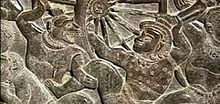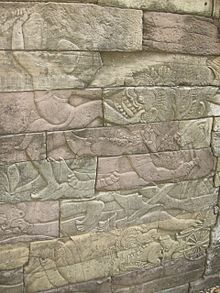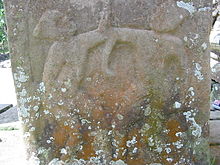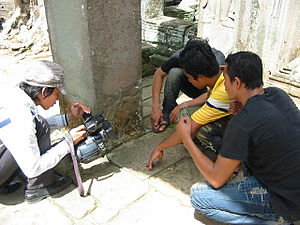- Pradal serey
-
Pradal Serey 
A Khmer boxing match before the western ring was introducedAlso known as Kun Khmer, Khmer Boxing, Kbachkun Pradal Khmer Focus striking Hardness full-contact Country of origin  Cambodia
CambodiaFamous practitioners Eh Phoutong, Bun Sothea Parenthood Kbachkun Boran Khmer, Yuthakun Khmer Khom Olympic sport no Pradal serey is an unarmed martial art from Cambodia. In Khmer the word pradal means fighting or boxing and serey means free. Originally used for warfare, pradal serey is now one of Cambodia's national sports. Its moves have been slightly altered to comply with the modern rules.
Pradal serey is mostly the same as unarmed kbach kun boran except it does not include mae (core techniques), tvear (door system that emphasizes footwork). Instead, it focuses more on winning a bout. While most well-known for its kicking technique, which generates power from hip rotation rather than snapping the leg, pradal serey consists of four types of strikes: punches, kicks, elbows and knee strikes. The clinch is used to wear down the opponent. Compared to other forms of Southeast Asian kickboxing, pradal serey emphasizes more elusive and shifty fighting stances. The Cambodian style tends to utilize more elbows than that of other regions. More victories come by way of an elbow technique than any other strikes.
Contents
History
A scene depicting blocking a kick on a bas-relief from the Angkor region.
Fighting has been a constant part of Southeast Asia since ancient times and eventually led to organized combat systems. In the Angkor era, both armed and unarmed martial arts were practiced by the Khmers. Evidence shows that a style resembling pradal serey known as bokator existed in the 9th century, which may be one of the reasons why the Khmer empire was such a dominant force in Southeast Asia.[1] The kingdom of Angkor used an early form of pradal serey, named Yuthakun khmer khom, along with various weapons and war elephants to wage war against their main enemy, the Vietnam-based kingdom of Champa, and later, Siam.[2][3] Re-enactments of elephant battles are still recreated at the Surin Elephant Round-up.
At this time, the kingdom of Angkor dominated and controlled most of what is now Cambodia, Thailand, Vietnam and Laos.[4] As a result, Cambodia has influenced much of Thai and Lao culture.[5] This leads the Khmer to believe all Southeast Asian forms of kickboxing started with the early Mon-Khmer people; they maintain thatPradal serey derived from bokator and went on to form the basis for Muay Thai.[6] On top of oral stories from their ancestors, the basis of this argument are the bas-reliefs left behind by early Khmers in the ancient temples of the Bayon and other Angkor temples. Much of the writing on ancient Khmer art has either been destroyed or adopted by the invading Thai armies when the Siamese sacked and looted Angkor and took Khmer captives including members of the Khmer royal court back to Ayutthaya.[7] The Khmer warrior-king Jayavarman VII and the founder of a unified Laos, Fa Ngum, were among the military leaders believed to have been trained in the old fighting styles of Cambodia.
During the colonial period, martial arts like pradal serey were considered by the European colonists to be brutal and uncivilised. The French turned the art into a sport by adding timed rounds, a boxing ring and western boxing gloves in an attempt to lessen injury. Originally matches were fought in dirt pits with limited rules while hands were wrapped in rope. Some matches had boxers wrap seashells around their knuckles to increase the damage that could be inflicted. In the 1960s, Cambodian boxing promoters held inter-martial art exhibitions.[8]
Downfall and revival of pradal serey
During the chaos of the Vietnam War, Cambodia was undergoing its own civil war. On April 17, 1975, the Maoist Communist rebels, the Khmer Rouge, overthrew the government of the Khmer Republic led by Lon Nol after America left the Vietnam War. The Khmer Rouge's plan was to eliminate modern society and create an agricultural utopia.[9] The Khmer Rouge executed educated people, others who had ties to the old government or anyone who was believed to be advantaged by the old society (doctors, teachers, soldiers, actors, singers, boxers, etc.) and forced the remaining Khmer population into labor camps, in which many died of starvation and diseases, to be re-educated under the new government. Traditional martial arts were banned at this time and many boxers were executed or worked to death, which nearly caused the death of pradal serey. An estimated 1.7 million Cambodians or 21% of the population died during the Khmer Rouge regime according to the studies of the Cambodia Genocide Program of Yale University.[10] This lasted for four years until 1979 when the Vietnamese along with ex-Khmer Rouge officers, including current prime minister Hun Sen, overthrew the Khmer Rouge. During the relative peace since the departure of the Vietnamese and the re-establishment of the Kingdom of Cambodia, the country's traditional arts were revived, including pradal serey.[11]
Pradal serey is making a strong comeback since its prohibition in the 1970s.[12] Cambodia is making an attempt to market their style of boxing at the same caliber as Muay Thai even though its status as a fourth world country renders a lack of financial funding. Numerous gyms have opened and large masses of students, local and foreign, have come to train in Cambodia. There are weekly matches held, the majority televised live, and many of Cambodia's best have traveled internationally to compete. There are currently approximately 70 boxing clubs nationwide.[13]
Pradal serey is administered in Cambodia by the Cambodian Boxing Federation (CBF), formerly the Cambodian Amateur Boxing Federation (CABF). All referees, judges and fighters must be licensed by the CABF. Television stations which hold Khmer boxing tournaments do so under the supervision of the CBF. The individual stations are responsible for organising boxers, trainers, medical staff and musicians. The CBF supplies the match referees, judges and time-keepers. The current president of the CBF is Major-General Tem Moeun.[14] [15] [16] Abroad, Cambodian boxing is promoted by 4 organizations. These organizations include the European Khmer Boxing Federation based in Germany, the Fédération des Arts Martiaux Khmers also called FAMK, based in France, the Anh Binh Minh Khmer Martial Arts Association in Vietnam and Kun Khmer Australia based in Australia. Other newly created organizations can be found in Spain and Italy, while Belgium is in the process of forming its own Khmer boxing organization.[17] The International Sport Kickboxing Association based in the United Kingdom have held matches involving Cambodian boxers. Khmer boxers have fought abroad in countries such as Korea.[18]
There have been concerns about the betting and rowdiness among pradal serey fans.[11] Cambodian trainer Chiit Sarim had this to say about the difference between the boxing scene then and now, "I traveled from pagoda to pagoda to box at competitions during the water festival. Pagodas were the traditional venue for boxing matches... They [the current fans] act inappropriately. They raise up their hands and scream noisily. They gamble and do not respect the boxers. They think of only winning their bet. During my time, there was no such thing. Fights were organized nicely and were very popular. Now fans have no morality".
 Khmer traditional boxing announcer table at the CTN station.
Khmer traditional boxing announcer table at the CTN station.
Tournaments are screened live on national television. TV5 holds live tournaments on Friday and Sunday, CTN holds live tournaments on Saturday and Sunday.[19] Bayon Television holds live kickboxing tournaments on Saturday and Sunday,[20] while TV3 holds a single tournament on Sunday and Apsara TV has added a single tournament on Thursday.
Recent exposure to pradal serey in the western world have come from travel journalists and tourists. In addition, pradal serey was featured on The History Channel's Human Weapon and mentioned on the Cambodian episode of Globetrekker.[21]. In February, 2009, American footballer Dhani Jones filmed an episode of his series Dhani Tackles the Globe in Phnom Penh, training with Long Salavorn at the Salavorn Keila club and fighting Pan Phanith at the CTN arena. [22]
Songchai Ratanasuban, the number one promoter in Thailand, brought his S1 Promotion to Phnom Penh in June 2005. In the Cambodian S1 World Championship, Bun Sothea won the tournament. He defeated Michael Paszowski, Dzhabar Askerov and Lor Samnang in front of 30,000 people at the Phnom Penh National Olympic Stadium.
In 2008 Cambodian Television Network (CTN) screened a pradal serey reality television series called Kun Khmer Champion. The show featured 65 kilogramme boxers and was produced by Ma Serey and Aaron Leverton and co-hosted by Ma Serey and Cambodia's most famous kickboxer, Eh Phoutong. The first series was followed by a second in 2009 and a third in 2010, both co-hosted by Vorn Viva.
On August 28, 2008, Cambodian boxers Vorn Viva and Meas Chantha won the ISKA Middleweight and Welterweight world titles in Phnom Penh. It was the first time a Cambodian had held a kickboxing world title.[23]
Attempt to unite boxing styles
At an ASEAN meeting in 1995 regarding the upcoming King's Cup Muay Thai competition, Cambodia wanted to rename Muay Thai as "Sovannaphum boxing" or "SEA Boxing", which represented Thailand, Cambodia, Laos and Myanmar. Sovannaphum means "golden land" in Khmer and is written as Suwannabhumi in Thai. The name refers to mainland Southeast Asia in the Indian language of Pali.
Thailand would not compromise, stating that each Southeast Asian country has its own boxing style and that Thailand was responsible for making its kickboxing an international sport. At the 2005 Southeast Asian Games, Cambodia did not enter the Muay Thai event in protest of the name used to refer to the sport.[24]
Life as a Neak Pradal
Most Neak Pradal (Cambodian boxer) come from a poor background and compete to earn money to feed their families and themselves. Their average from age 14 to 25. Top keilakors (kickboxers) can have as many as 300 fights in their careers.[25]
Neak Pradal were traditionally paid by the crowd. If the crowd appreciated the boxer's efforts, they would reward him with food, alcohol and cash. This practice still continues today but, in line with western practice, bouts pay official fees. Until recently the average purse for a fight was US$15. Today purses are based on experience. A new Neak Pradal can earn US$25 per fight. More experienced Neak Pradal's with more than a dozen fights can earn up to $75. "Brand name" Neak Pradal's can earn over $100 a fight. Special purse fights will pay up to $250 with the purse contributed by a corporate sponsor. "International" tournaments, organised by the broadcasters, will pay individual purses of up to $1000, sometimes higher.[25]
Some of the best Pradal Serey champions come from the Battambang Province although a number of big name stars have come via Southern Cambodia such as Eh Phoutong from Koh Kong Province, Thun Sophea from Svay Rieng Province and Meas Chantha and Seng Makara from Kandal Province. Neak Pradal train in a gym under a Pradal Serey kru. Many boxers train 6–8 hours a day and 7 days a week.
Health risk
As with all contact sports, health risks are a factor. According to Chhoeung Yavyen, a ringside doctor for the Cambodian Amateur Boxing Association, in the past five years 30 kick boxers have sustained serious injury in the ring including broken wrists and arms, broken shins, broken noses, dislodged shoulders, hip injuries and broken jaws. One neak pradal (Cambodian boxer) died in the ring in Svay Rieng Province in 2001, but that death was the result of a heart attack, probably brought on by diet pills consumed to help the neak pradal (Cambodian boxer) reduce his weight before the bout. Most of the injuries suffered are curable and don't leave lasting problems. Most neak pradal (Cambodian boxer) are allowed to return to the ring after receiving treatment.[26]
Rules and match setup
A match consists of five three-minute rounds and takes place in a 6.1 meter square boxing ring. A one-and-a-half or two minute break occurs between each round. At the beginning of each match the boxers practice the praying rituals known as the kun kru. Traditional Cambodian music performed with the instruments skor yaul (a type of drum), the sralai (reed flute) and the chhing, is played during the match. Modern boxers wear leather gloves and nylon shorts.[27]
- Rules
- A boxer is not allowed to strike his opponent while he is on the ground.
- A boxer is not allowed to bite.
- When an opponent cannot continue, the referee stops the fight.
- Blows to the back of the opponent are not allowed.
- A boxer may not hold on to the ropes.
- Blows to the genitals are prohibited.
Victory can be obtained by knockout. A knockout occurs when a boxer is knocked down to the ground and cannot continue fighting after a 10 second count by the referee, a referee may forgo the count and declare a knockout if it is obvious the boxer will not regain his feet unaided. Victory can be obtained at the end of the match when judges decide by a point system which fighter was more effective. If fighters end up with the same score a draw is called.[27]
Promoters
- Ma Serey
Notable Khmer boxers
- Eh Phoutong: TV5 Champion, Khmer Traditional Kickboxing Champion, Prime Minister Samdech Hun Sen champion
- Ot Phoutong: TV5 kickboxing champion
- Vorn Viva: ISKA Middleweight World Champion
- Meas Chanta: ISKA Welterweight World Champion, 2nd Cambodian S1 champion, 2006 CTN 67 kg kickboxing runner up
- Yuth Phouthorng: Koh Kong Province governor and original teacher of Eh Phouton[28]
- Thun Sophea: 2006 CTN 67 kg kickboxing champion
- Bun Sothea: Cambodian S1 champion
- Oumry Ban: Cambodian champion prior to Democratic Kampuchea and current trainer in Long Beach, California
- May Sopheap: 2007 CTN 67 kg kickboxing champion
- Ven Savath: 2007 CTN 67 kg kickboxing runner up
See also
- Kbach kun boran
- Khmer traditional wrestling
- Lethwei
- Muay Lao
- Tomoi
References
- ^ Swann, Wim. 21st century Cambodia: view and vision. 2009: Global Vision Publishing Ho. p. 214. ISBN 9788182202788.
- ^ Ray, Nick; Daniel Robinson, Greg Bloom (2010). Cambodia. Lonely Planet. p. 99. ISBN 9781741794571.
- ^ Ooi, Keat Gin (2004). Southeast Asia: a historical encyclopedia, from Angkor Wat to East Timor, Volume 2. ABC-CLIO. pp. 488. ISBN 9781576077702.
- ^ Michael Freeman, Claude Jacques: Ancient Angkor, Asia Books, ISBN 974-8225-27-5.
- ^ Cambodia: History, britannica.com (retrieved January 28, 2009).
- ^ Ranges, Trevor; Kris LeBoutillier (2010). National Geographic Traveler Cambodia. National Geographic Books. p. 82. ISBN 9781426205200.
- ^ The Ayutthayan period, britannica.com (retrieved November 5, 2006).
- ^ Gray, Ralph (October 24, 1966). "Cambodian Boxing". National Geographic School Bulletin (National Geographic) 128 (7).
- ^ Sites, Kevin. July 18, 2006. Year Zero, Yahoo.com (retrieved November 5, 2006)
- ^ "Cambodia Genocide Project | Yale University." Cambodian Genocide Project.(retrieved 16 Jan. 2009)
- ^ a b Munthit, Ker (11/7/2001). "Sport of kickboxing felled by Khmer Rouge returns". Cambodian Online (Associated Press). http://www.cambodianonline.net/articles200493.htm. Retrieved 2/17/2011.
- ^ Stockmann, Hardy (1974). "Khmer Kickboxers No Match for Bangkok Fighters". Black Belt 12 (8): 62.
- ^ "Kick! Kick! Punch!". Shanghai Star. 11/7/2001. http://app1.chinadaily.com.cn/star/2001/0607/sp28-1.html. Retrieved 11/04/2006.
- ^ http://www.paddysgym.com/news/2010/01/02/tem-moeun-voted-new-cabf-president/
- ^ http://www.phnompenhpost.com/index.php?option=com_jcs&view=jcs&layout=form&Itemid=0
- ^ http://www.youtube.com/watch?v=7TCkNO5QCNw
- ^ Rahn, Cornelius. December 17, 2008. Monday night's all right for fighting in Phnom Penh, Phnompenhpost.com (retrieved January 19, 2009)
- ^ Sokheng, Vong. June 11, 2008. Cambodian kick boxers triumph in South Korea, Phnompenhpost.com (retrieved January 19, 2009)
- ^ "TV5 Cambodia Friday Schedule". Channel 5 Cambodia. 2011. http://www.ch5cambodia.com/TV5program_FRIDAY.htm. Retrieved 02/17/2011.
- ^ "Angkor Youth Boxing Club » Weekend wrap up". Paddy's Gym. 2008. http://www.paddysgym.com/news/2008/03/20/weekend-wrap-up-9/. Retrieved 02/17/2011.
- ^ "Cambodian Bloodsport". Human Weapon. Bill Duff, Jason Chambers. History Channel. 16 November 2007
- ^ http://www.paddysgym.com/news/2009/02/02/dhani-jones-v-pan-panith/
- ^ http://www.paddysgym.com/news/
- ^ "Cambodia to boycott Thai boxing event over name row". Turkish Daily News (Turkish Daily News). 2005.
- ^ a b Mallon, Scott (2003). "Traditional Khmer Boxing, The Comeback". Iron Life Magazine 2 (11). http://www.ironlife.com/mag/issue11/traditional2a.shtml. Retrieved 02/17/2011.
- ^ Roeun, Van; Kevin Doyle (08/23/2011). "Fight Club Cambodia". The Cambodia Daily. http://www.camnet.com.kh/cambodia.daily/selected_features/fight_club.htm. Retrieved 02/17/2011.
- ^ a b Vongs, Moul (12/1/2001). "Khmer Boxing". Leisure Cambodia 1 (7). http://www.leisurecambodia.com/Leisure_Cambodia/No.07/boxing.htm. Retrieved 02/17/2011.
- ^ Sothy, Meun (2004). "Khmer kickboxing club established for young generation boxers". Cambodiantown.com. http://www.cambodiantown.com/newsthree.htm. Retrieved 11/5/2006.
External links
- European Khmer Boxing Federation
- Fédération des Arts martiaux Khmers
- The Current Situation of Cambodia's Ancient Fighting Arts
- Interview With Eh Phu Tong
- Khmer Kickboxing Art Felled by Khmer Rouge Makes Comeback
- A night at the kickboxing: Going for the Goolies in Phnom Penh
- Sunrise Bradahl Serey Kru Sarun Chea
- Cambodian Online-Women on top in boxing revival
- Khmer Boxing news from Cambodia
Martial arts Regional origin Unarmed Weapons Training Grappling Folk wrestling · Brazilian Jiu-Jitsu · Catch Wrestling · Judo · Lucha Libre · Shoot wrestling · Greco-Roman wrestling · Freestyle wrestling · JujutsuFull contact sports Bare-knuckle boxing · Boxing · Full contact karate · Kickboxing · Mixed martial arts · Muay Thai · Sanshou · Shooto · Sambo · TaekwondoSelf-defense/Combatives Entertainment Categories:- Cambodian martial arts
- Combat sports
Wikimedia Foundation. 2010.




